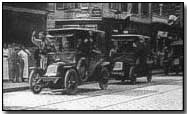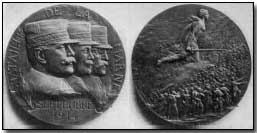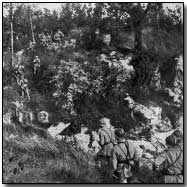Battles - The First Battle of the Marne, 1914

The First Battle of the Marne was conducted between 6-12 September 1914, with the outcome bringing to an end the war of movement that had dominated the First World War since the beginning of August. Instead, with the German advance brought to a halt, stalemate and trench warfare ensued.
Having invaded Belgium and north-eastern France, the German army had reached within 30 miles of Paris. Their progress had been rapid, having successfully beaten back Belgian, French and British forces in advancing deep into north-eastern France. Their advance was in pursuance of the aims of the Schlieffen Plan, whose primary focus was the swift defeat of France in the west before turning attention the Russian forces in the east.
As the German armies neared Paris, the French capital prepared itself for a siege. The defending French forces (Fifth and Sixth Armies) - and the British - were at the point of exhaustion, having retreated continuously for 10-12 days under repeated German attack until, directed by Joseph Joffre, the French Commander-in-Chief, they reached the south of the River Marne.
With victory seemingly near, Alexander von Kluck's German First Army was instructed to encircle Paris from the east. The French government, similarly expecting the fall of the capital, left Paris for Bordeaux.
Joseph Joffre, imperturbable in the face of crisis, resolved on 4 September to launch a counter-offensive strike, under the recommendation of the military governor of Paris, Gallieni, and aided by the British under Sir John French (the latter only after prompting by the British war minister, Lord Kitchener).
 Joffre
authorised
General Maunoury's Sixth Army - comprising 150,000 men - to
attack the right flank of the German First Army in an action beginning on
the morning of 6 September. In turning to meet the French attack a 30
mile wide gap appeared in the German lines between the First and Second
Army, the latter commanded by the cautious General
Karl von Bulow.
Joffre
authorised
General Maunoury's Sixth Army - comprising 150,000 men - to
attack the right flank of the German First Army in an action beginning on
the morning of 6 September. In turning to meet the French attack a 30
mile wide gap appeared in the German lines between the First and Second
Army, the latter commanded by the cautious General
Karl von Bulow.
The Allies were prompt in exploiting the break in the German lines, despatching troops from the British Expeditionary Force (BEF) to join the French Fifth Army in pouring through the gap between the two German armies, the right wing of Fifth Army simultaneously attacking the German Second Army.
Nevertheless, the German forces were close to achieving a breakthrough against Maunoury's beleaguered forces between 6-8 September, and were only saved on 7 September by the aid of 6,000 French reserve infantry troops ferried from Paris in streams of taxi cabs, 600 in all.
The following night, on 8 September, the aggressive French commander General Franchet d'Esperey's Fifth Army launched a surprise attack against the German Second Army, serving to further widen the gap between the German First and Second Armies. D'Espery was a recent appointment, Joffre having given him command of Fifth Army in place of the dismissed General Lanrezac, who was deemed too cautious and wanting in 'offensive spirit'.
 On
9 September the German armies began a retreat ordered by the German Chief of
Staff Helmuth von Moltke.
Moltke feared an Allied breakthrough, plagued by poor communication from his
lines at the Marne.
On
9 September the German armies began a retreat ordered by the German Chief of
Staff Helmuth von Moltke.
Moltke feared an Allied breakthrough, plagued by poor communication from his
lines at the Marne.
The retreating armies were pursued by the French and British, although the pace of the Allied advance was slow - a mere 12 miles in one day. The German armies ceased their withdrawal after 40 miles at a point north of the River Aisne, where the First and Second Armies dug in, preparing trenches that were to last for several years.
In a strategic triumph at the First Battle of the Marne, which ended on 10 September, the French forces - assisted by the British - had succeeded in throwing back the German offensive, recapturing lost ground in the process. More importantly, the battle ended any hopes the Germans had of effectively bringing the war on the Western Front to an early close.
Casualties at the battle were heavy. The French incurred 250,000 losses, and it is believed that the Germans suffered similar casualties (no official figures are available). The British recorded 12,733 casualties among the BEF.
Click here to view Joffre's report to the French Minister of War; click here to read Sir John French's report. Click here to read German First Army commander Alexander von Kluck's account of the decision to retreat.
To view maps charting the progress of the Marne battle click here; here; here; here and here. Click here to view a map of the subsequent German retreat.
Photographs courtesy of Photos of the Great War website
Bulgaria mobilised a quarter of its male population during WW1, 650,000 troops in total.
- Did you know?
